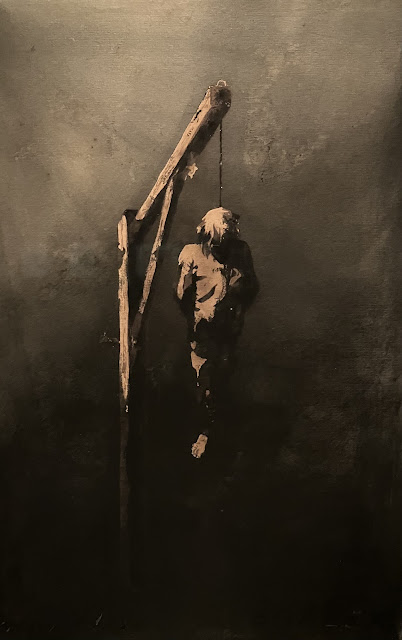'Behold The Law' - Asides (XVIII)
Realising that you are opposed to something is subtly different from the natural act of being opposed to something. The sudden awareness that something is quite wrong, that it does not make any sense - and furthermore, that you’ve always instinctively felt this way - is almost always triggered by a second party, someone rationalising a particular position and getting you to think about it critically for the first time. And so it was, that reading Victor Hugo and remarks on his worldview in the introduction to my copy of Les Misérables allowed me to see that I’d always been opposed to the death penalty.
 |
Victor Hugo, Mushroom (1850) |
Les Misérables was the second of the putative classics that I ever read. The first was Thomas Hardy’s Far From the Madding Crowd, which provokes the thought that I might have got to my epiphany quicker if I’d begun with Tess of the d'Urbervilles. No matter, the knowledge that Hugo was a lifelong opponent of the death penalty, and that he viewed it as barbaric and having no place in civilised society, struck me as common sense.
*
“What is the death penalty? The death penalty is the special and eternal sign of barbarism. Wherever the death penalty is imposed, barbarism dominates; wherever the death penalty is rare, civilization reigns. These are the incontestable facts. The easing of the death penalty represents important and serious progress. A great part of the glory of the 18th century is its abolition of torture; the 19th century will certainly abolish the death penalty.”
*
Leaving aside Hugo’s misplaced optimism about the 19th century and beyond, and following up on those biographical asides with a full and glorious reading of Les Misérables, my views on this one issue were cemented, and no doubt also started to shape my political sensibilities and push them towards liberalism.
I was reminded of this epiphany a few weeks ago. On paying a visit to The Royal Academy’s eye-opening exhibition of Hugo sketches - aptly titled Astonishing Things - a talent of his that I’d only been vaguely aware of, I came face to face with a drawing that brought the memory rushing back.
 | |
|
Hugo’s 1854 sketch Ecce Lex is a brutal and economical depiction of the executed murderer John Tapner who was hanged in Guernsey. ‘Behold the law’ indeed. This work in pen and brown ink wash, touched up with graphite pencil, black ink and charcoal is startling. The drooped head, its mop of blonde hair - or is that the work of the moonlight? - that straight, limp body; the one grotesque and visible foot; all of this works upon you viscerally. And the angle of the gallows stanchion, pointing to one o’clock - I wonder why that particular thought jumped straight into my head? - brought me to a long and sober standstill. All of the complications of justice, morality, punishment, anger, grief, deterrent, are reduced to this pale and monochromatic binary. And binaries - such as an ‘eye for an eye’ - just won’t do in such a complex world, not least in the banality and lack of imagination that are inherent in revenge. Revenge is not justice, even if you think it feels like it. If you disagree with this - and I'll even let you leave aside the numerous miscarriages of justice that have been recorded in the negative column of capital punishment (Tapner’s execution may well have been one) - dig a little deeper and ask yourself, in what way has the death penalty advanced mankind?
 |
Victor Hugo, The Lighthouse at Casquets (1866) |
The exhibition as a whole was dazzling, piquant and surprising, and one that made me rue the fact that I had only got to see it a day before it closed. Hugo’s Mushroom and The Lighthouse at Casquets might have detained me for hours. I would certainly have returned, and not just to take in the drawing that took my back to my early twenties and that first encounter with Jean Valjean, Gavroche and Inspector Javert (such a late starter with serious literature). Astonishing things, indeed!


Comments
Post a Comment